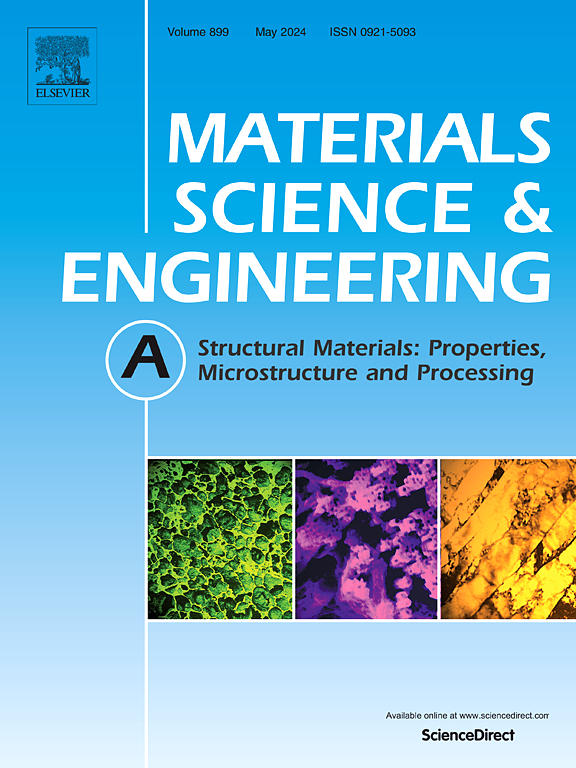Achieving excellent plasticity performance in non-equiatomic FCC CoCrFeNiMoMn high-entropy alloys via arc-based direct energy deposition
IF 6.1
2区 材料科学
Q1 MATERIALS SCIENCE, MULTIDISCIPLINARY
引用次数: 0
Abstract
High-entropy alloys (HEAs) are a relatively new class of materials with exceptional properties, offering promising applications in aerospace, nuclear industry, and hydrogen storage. Alongside alloy design and development, recent research on HEAs has focused on exploring different manufacturing processes and resulting properties. This study demonstrates the practicality of leveraging an ultra-high-frequency Tungsten Inert Gas (TIG)- heat source during directed energy deposition (DED) with dual alloy wires, to fabricate non-equiatomic CoCrFeNiMoMn HEAs for the first time. A comprehensive analysis of the microstructural evolution and mechanical properties of as-deposited HEAs and those post-heat treated based on CALPHAD methodology is detailed. The microstructural and elemental homogeneity was markedly enhanced through the application of ultra-high-frequency pulsed current (UHFPC), yielding a non-equiatomic CoCrFeNiMoMn alloy with a ductile FCC matrix in the as-deposited state. In the post-heat treatment condition, the FCC matrix underwent recrystallization and L21 phase precipitated at grain interiors and boundaries. These precipitates conferred significant strength to the HEA through precipitation hardening by effectively obstructing dislocation motion at incoherent interfaces, while the accompanying lattice misfit and dislocation networks further amplified the alloy's mechanical properties. The CALPHAD-guided heat treatment protocol notably elevated the performance metrics, achieving a 54.2 % enhancement in yield strength and a 42 % improvement in ultimate tensile strength, all while retaining commendable elongation. This work offers valuable insights into the potential of cost-effective TIG-based dual wire DED for the fabrication of HEAs with precisely tailored microstructures and properties, rendering them ideal for advanced applications.
采用电弧基直接能量沉积法制备非等原子FCC CoCrFeNiMoMn高熵合金,获得了优异的塑性性能
高熵合金(HEAs)是一类相对较新的材料,具有优异的性能,在航空航天、核工业和储氢方面具有广阔的应用前景。除了合金的设计和开发,最近对HEAs的研究主要集中在探索不同的制造工艺和产生的性能。该研究首次证明了利用超高频钨惰性气体(TIG)热源在双合金丝定向能沉积(DED)过程中制造非等原子CoCrFeNiMoMn HEAs的可行性。基于CALPHAD方法对沉积态HEAs和热处理后HEAs的显微组织演变和力学性能进行了全面分析。在超高频脉冲电流(UHFPC)作用下,CoCrFeNiMoMn合金的显微组织和元素均匀性得到了显著增强,在沉积状态下得到了具有韧性FCC基体的非等原子CoCrFeNiMoMn合金。热处理后,FCC基体发生再结晶,在晶内和晶界处析出L21相。这些析出相通过析出硬化有效地阻碍了位错在非共格界面的运动,从而使HEA具有显著的强度,而伴随的晶格错配和位错网络进一步增强了合金的力学性能。calphad引导的热处理方案显著提高了性能指标,屈服强度提高了54.2%,极限抗拉强度提高了42%,同时保持了良好的伸长率。这项工作为具有成本效益的基于tig的双线DED的潜力提供了有价值的见解,用于制造具有精确定制微结构和性能的HEAs,使其成为先进应用的理想选择。
本文章由计算机程序翻译,如有差异,请以英文原文为准。
求助全文
约1分钟内获得全文
求助全文
来源期刊

Materials Science and Engineering: A
工程技术-材料科学:综合
CiteScore
11.50
自引率
15.60%
发文量
1811
审稿时长
31 days
期刊介绍:
Materials Science and Engineering A provides an international medium for the publication of theoretical and experimental studies related to the load-bearing capacity of materials as influenced by their basic properties, processing history, microstructure and operating environment. Appropriate submissions to Materials Science and Engineering A should include scientific and/or engineering factors which affect the microstructure - strength relationships of materials and report the changes to mechanical behavior.
 求助内容:
求助内容: 应助结果提醒方式:
应助结果提醒方式:


